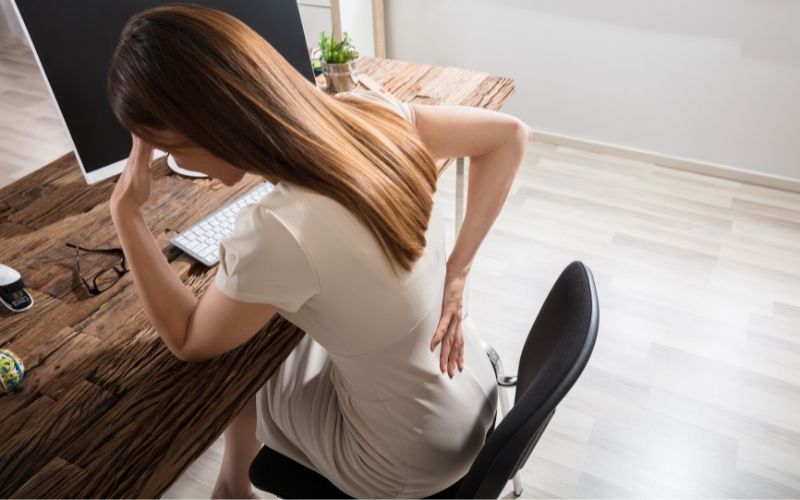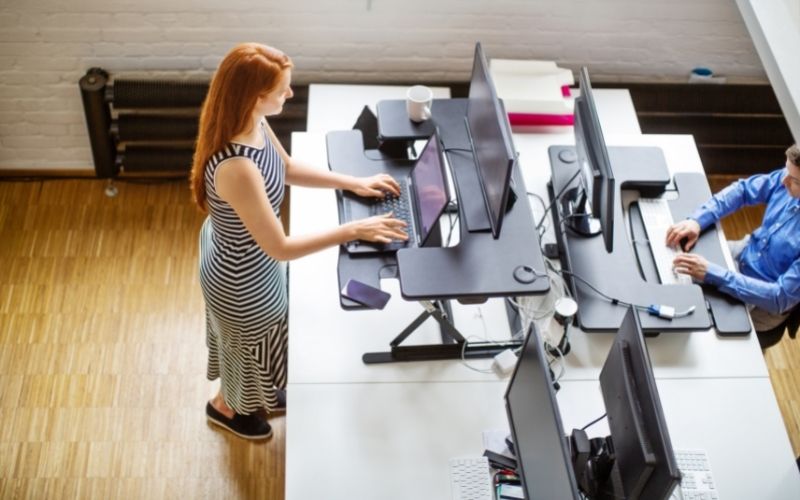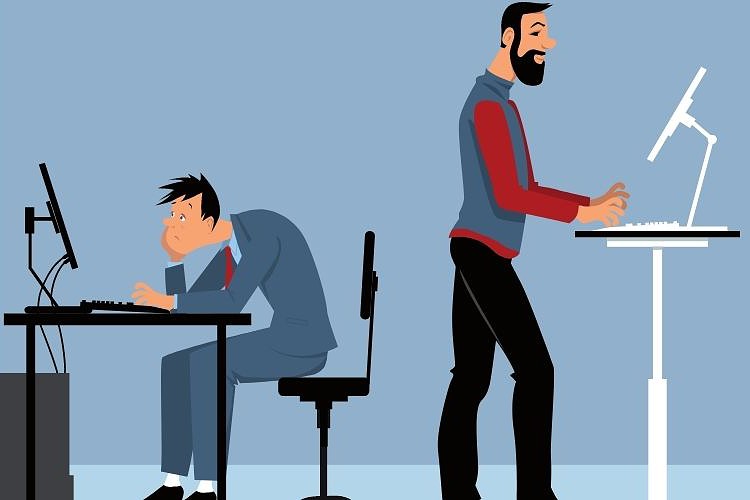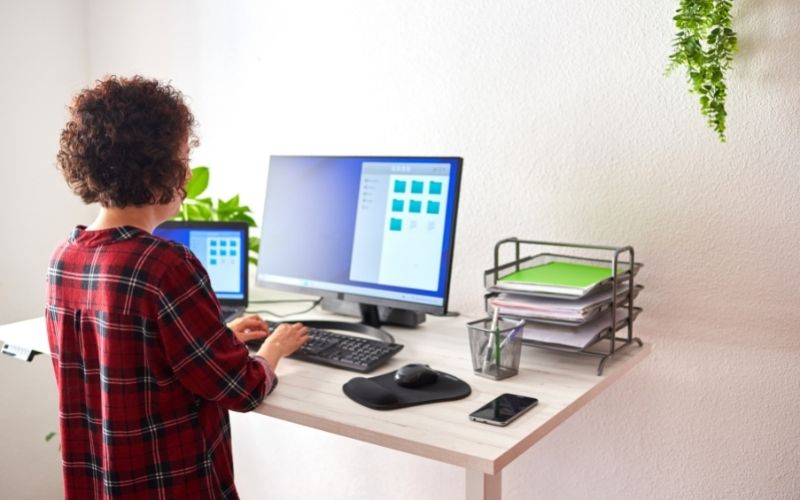By now, you’re probably already aware of the studies revealing the health risks that come from sitting too much. Sitting for hours leads to a sedentary lifestyle, which unfortunately contributes to health issues like type 2 diabetes, heart disease, and a shorter life expectancy.
As a solution, standing desks were introduced.
But do standing desks make a difference?
The answer is yes, but not in the way you might think.
According to studies, the most significant benefit of using a standing desk is it can correct your posture, ease any discomfort, and improve core strength. Beyond that, any other health benefits you can get will require constantly moving and avoiding static postures by switching between sitting and standing positions.
However, standing also helps keep you alert and awake, which lets you engage more with co-workers in an office setting. It does have a few cons as well, like soreness in your legs and feet, days that feel “longer,” and fatigue if you recently switched to this set-up.
Table of Contents
Why Is Sitting So Bad for Us?

In recent years, a steady stream of studies has linked sitting for hours on end with several health concerns, including cancer and early death. Unfortunately, work for many people often means sitting for a prolonged period, often with few rests.
But while it’s easy to dismiss this type of routine as a regular part of adult life, evidence shows that it’s contributing to a ton of health issues, including:
- Lower back pain and spine issues
- Vascular problems
- Weight gain and obesity
- Lower life expectancy
- Cancer
- Heart Disease
All of this is simply because our bodies are not made to sit all day, let alone hunch over a desk typing away at a computer. The upside is, constant exercise can do a lot to help negate these harmful effects, especially when combined with a consistent and healthy diet.
But for those people that don’t always have time to exercise, is there another option?
How Can Standing Desks Help?

This is where standing desks come into the picture. At least, that was the message behind these ubiquitous pieces of furniture when they first came out.
As one of the most popular trends in office ergonomics, the deal is that standing desks negate the harmful effects of sitting by letting you stand instead. It was even advertised to help you lose weight by activating your core and idly burning calories.
But do they work?
Well, they do work, but for entirely different reasons.
First off, standing desks are unlikely to help you with weight loss or avoiding weight gain. While standing burns calories, the amount getting burnt isn’t enough to make a difference.
For comparison, you can burn more calories climbing up one flight of stairs.
And because standing desks don’t contribute to weight loss, it’s also unlikely that they will decrease your chances of developing severe health issues like heart disease, type 2 diabetes, or some types of cancer.
This is because while you’re standing, you’re still a largely inactive person at the end of the day.
The truth is, standing desks were vastly overhyped and falsely advertised. Stagnation in any form can cause problems, regardless of whether you’re sitting or standing.

That said, standing desks do have their benefits. This includes:
- Better Posture and Less Back Pain – While it’s not the best solution, standing will always be better than sitting, so slowly changing into a standing desk set-up will do wonders for your lower back and eventually improve your posture.
It’s not a cure-all, but learning how to maintain good posture can ease a lot of lower back discomfort while also strengthening your core muscles for better stability. - Alertness and Increase in Productivity – When you’re standing, your muscles are activated, and your blood can flow more freely. In turn, this helps you become more alert in general, which you can then use to boost your work productivity and get things done quicker.
- More Engagement with Others – In an office setting (sorry remote workers!), standing desks can quickly become centralized hubs for coworkers constantly talking, engaging, and collaborating, which can help foster a more positive and lively work environment.
What’s The Long-Term Solution?

Unfortunately, the standing desk benefits mentioned above do not reverse the harmful effects of sitting and being sedentary for years.
In fact, the problem isn’t sitting but rather, leading a sedentary lifestyle.
And the best way to combat this will always be movement. Everything from blood circulation to digestion requires movement to work correctly, and the same principle applies to us physically.
This means that alongside regular exercise, you need to stay active while at work. Luckily, there are plenty of ways to do this, like:
- Using the stairs instead of the elevator
- Setting a timer to go on physical and mental breaks
- Constantly drinking water to hydrate yourself and taking frequent breaks to encourage movement
- Using a therapy ball chair instead of a regular office chair
- Going on lunchtime walks to remain active
- Wearing a fitness tracker for reminders
- Going on walking meetings with your colleagues
- Incorporating some seated exercises
- Using a foam roller to ease posture pain
Another good alternatives to standing desks are so-called “sit-stand desks,” which provide a hybrid set-up by letting you switch between sitting and standing at any time.

If you have the budget, the Flexispot EC1 provides tons of adjustments to match your height and comfort and can easily be lowered when you decide to sit down.
But if you’re on a remote work set-up and would like a convenient and more affordable option, then the lets you convert your desk into a standing one.
On paper, these more hybrid set-ups sound like the best of both worlds and show a lot of promise. However, since we haven’t used them long enough to provide conclusive results, the best long-term solution remains to stay active as much as you can.
Final Thoughts
At the end of the day, the real culprit is the sedentary lives we are inclined to live.
While standing desks are a possible solution to this problem, they’re not enough to make that big of a difference and even come with their own set of caveats.
So, until we find a better and longer-lasting solution to avoiding these possible health risks, our advice remains: keep moving.

My name is Vance, and I am the owner of To Ergonomics. Our mission is to improve your workflow by helping you create a supportive and welcoming environment. We hope that you’ll find what you’re looking for while you’re here.

